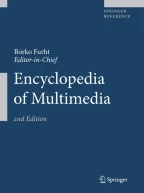Definition
Motion compensation has been used widely in video compression, because of its abilities to exploit high temporal correlation between successive frames of an image sequence.
Introduction
Video compression [1–4] plays an important role in modern multimedia applications. Inside digitized video, there is a considerable amount of redundancy and compression can be achieved by exploiting such redundancies. The redundancy of video data is generally divided into two classes: statistical redundancy and subjective redundancy. For statistical redundancy, it can be derived from the highly correlated video information both spatially and temporally. For example, adjacent picture elements of a television picture are almost alike and successive pictures often have small changes. Thus the differences among these similar elements are small, and hence the average bit-rate of video data can be saved by sending the differences of these similar...
Access this chapter
Tax calculation will be finalised at checkout
Purchases are for personal use only
References
V. Bhaskaran and K. Konstantinides, “Image and Video Compression Standards: Algorithms and Architectures,” Kluwer Academic, Dordrecht, 1995.
K.R. Rao and J.J. Kwang, “Techniques and Standards for Image, Video and Audio Coding,” Prentice-Hall, Englewood, Cliffs, NJ, 1996.
B. Vasuder, “Image and Video Compression Standard: Algorithms and Architectures,” Kluwer Academic, Dordrecht, 1997.
T. Ebrahimi and M. Kunt, “Visual Data Compression for Multimedia Applications,” Proceedings of the IEEE, Vol. 86, No. 6, June 1998, pp. 1109–1125.
A.N. Netravali and J.P. Robbins, “Motion Compensated Television Coding – Part I,” Bell System Technical Journal, Vol. 58, 1979, pp. 631–670.
F. Dufaux and F. Moscheini, “Motion Estimation Techniques for Digital TV: A Review and a New Contribution,” Proceedings of the IEEE, Vol. 83, 1995, pp. 858–876.
ISO/IEC, “Information Technology – Coding of Moving Pictures and Associated Audio for Digital Storage at up to about 1.5 Mbits/s – Part 2: Video,” ISO/IEC 11172-2 (MPEG-1), 1993.
ISO/IEC and ITU-T, “Information Technology – Generic Coding of Moving Pictures and Associated Audio Information – Part 2: Video,” ISO/IEC 13818-2 (MPEG-2) – ITU-T Recommendation H.262, 1996.
ISO/IEC, “Information Technology – Coding of Audio-Visual Object – Part 2: Visual,” ISO/IEC 14496-2 (MPEG-4), 1999.
ITU-T, “Video Codec for Audiovisual Services at p×64 kbit/s,” ITU-T Recommendation H.261, 1993.
ITU-T, “Video Coding for Low Bit Rate Communication,” ITU-T Recommendation H.263, 1996.
T. Wiegand, G.J. Sullivan, G. Bjøntegaard, and A. Luthra, “Overview of the H.264/AVC Video Coding Standard,” IEEE Transactions on Circuits and Systems for Video Technology, Vol. 13, July 2003, pp. 560–576.
J.R. Jain and A.K. Jain, “Displacement Measurement and its Application in Interframe Image Coding,” IEEE Transactions on Communications, Vol. COM-29, December 1981, pp. 1799–1808.
T. Koga, K. Iinuma, A. Hirano, Y. Iijima, and T. Ishiguro, “Motion Compensated Inter-Frame Coding for Video Conferencing,” Proceedings of the NTC81, New Orleans, LA, pp. C.9.6.1–C.9.6.5, November/December 1981.
M. Ghanbari, “The Cross Search Algorithm for Motion Estimation,” IEEE Transactions on Communications, Vol. 38, July 1990, pp. 950–953.
R. Li, B. Zeng, and M. Liou, “A New Three-Step Search Algorithm for Block Motion Estimation,” IEEE Transactions on Circuits and Systems for Video Technology, Vol. 4, No. 4, August 1994, pp. 438–442.
L.M. Po and W.C. Ma, “A Novel Four-Step Algorithm for Fast Block Motion Estimation,” IEEE Transactions on Circuits and Systems for Video Technology, Vol. 6, No. 3, June 1996, pp. 313–317.
K.L. Liu and E. Feig, “A Block-Based Gradient Descent Search Algorithm for Block Motion Estimation Algorithms in Video Coding,” IEEE Transactions on Circuits and Systems for Video Technology, Vol. 6, No. 4, August 1996, pp. 419–422.
J.Y. Tham, S. Ranganath, M. Ranganath, and A.A. Kassim, “A Novel Unrestricted Center-Biased Diamond Search Algorithm for Block Motion Estimation,” IEEE Transactions on Circuits and Systems for Video Technology, Vol. 8, August 1998, pp. 369–377.
S. Zhu and K.K. Ma, “A New Diamond Search Algorithm for Fast Block Matching Motion Estimation,” IEEE Transactions on Image Processing, Vol. 9, February 2000, pp. 287–290.
C. Zhu, X. Lin, and L.P. Chau, “Hexagon-based Search Pattern for Fast Block Motion Estimation,” IEEE Transactions on Circuits and Systems for Video Technology, Vol. 12, May 2002, pp. 349–355.
C. Zhu, X. Lin, L.P. Chau, and L.M. Po, “Enhanced Hexagonal Search for Fast Block Motion Estimation,” IEEE Transactions on Circuits and Systems for Video Technology, Vol. 14, No. 10, October 2004, pp. 1210–1214.
B. Liu and A. Zaccarin, “New Fast Algorithm for the Estimation of Block Motion Vectors,” IEEE Transactions on Circuits and Systems for Video Technology, Vol. 3, April 1993, pp. 148–157.
L.C. Chang, K.L. Chung, and T.C. Yang, “An Improved Search Algorithm for Motion Estimation Using Adaptive Search Order,” IEEE Signal Processing Letters, Vol. 8, No. 5, May 2001, pp. 129–130.
J.N. Kim, S.C. Byun, Y.H. Kim, and B.H. Ahn, “Fast Full Search Motion Estimation Algorithm Using Early Detection of Impossible Candidate Vectors,” IEEE Transactions on Signal Processing, Vol. 50, No. 9, September 2002, pp. 2355–2365.
K.R. Namuduri, “Motion Estimation Using Spatio-Temporal Contextual Information,” IEEE Transactions on Circuits and Systems for Video Technology, Vol. 14, No. 8, August 2004, pp. 1111–1115.
C. Zhu, W.S. Qi, and W. Ser, “Predictive Fine Granularity Successive Elimination for Fast Optimal Block-Matching Motion Estimation,” IEEE Transactions on Image Processing, Vol. 14, No. 2, February 2005, pp. 213–221.
Author information
Authors and Affiliations
Editor information
Editors and Affiliations
Rights and permissions
Copyright information
© 2008 Springer-Verlag
About this entry
Cite this entry
Feng, J., Lo, K.T. (2008). Motion Compensation for Video Compression. In: Furht, B. (eds) Encyclopedia of Multimedia. Springer, Boston, MA. https://doi.org/10.1007/978-0-387-78414-4_114
Download citation
DOI: https://doi.org/10.1007/978-0-387-78414-4_114
Publisher Name: Springer, Boston, MA
Print ISBN: 978-0-387-74724-8
Online ISBN: 978-0-387-78414-4
eBook Packages: Computer ScienceReference Module Computer Science and Engineering
